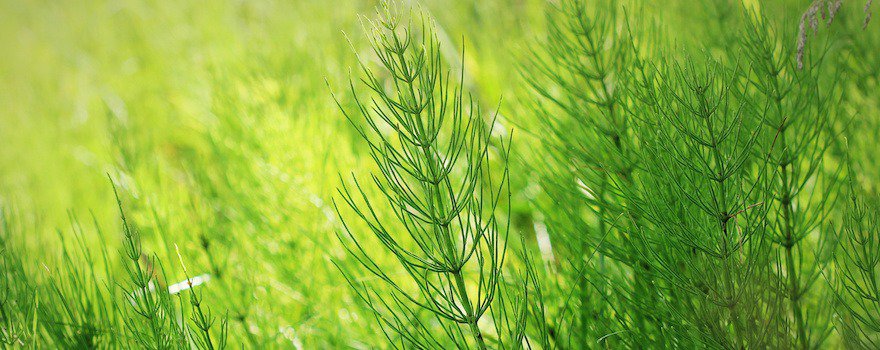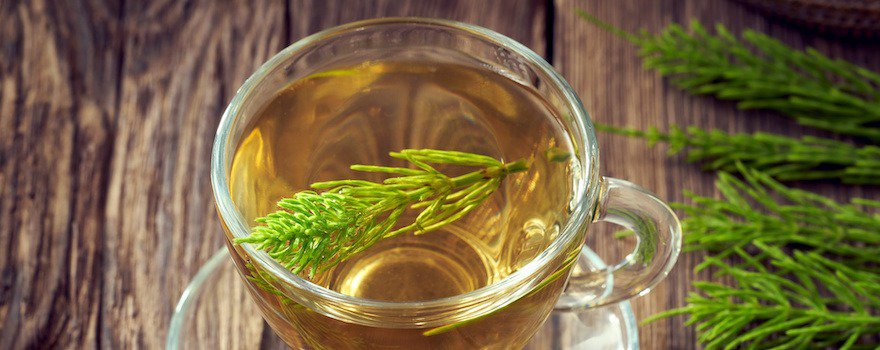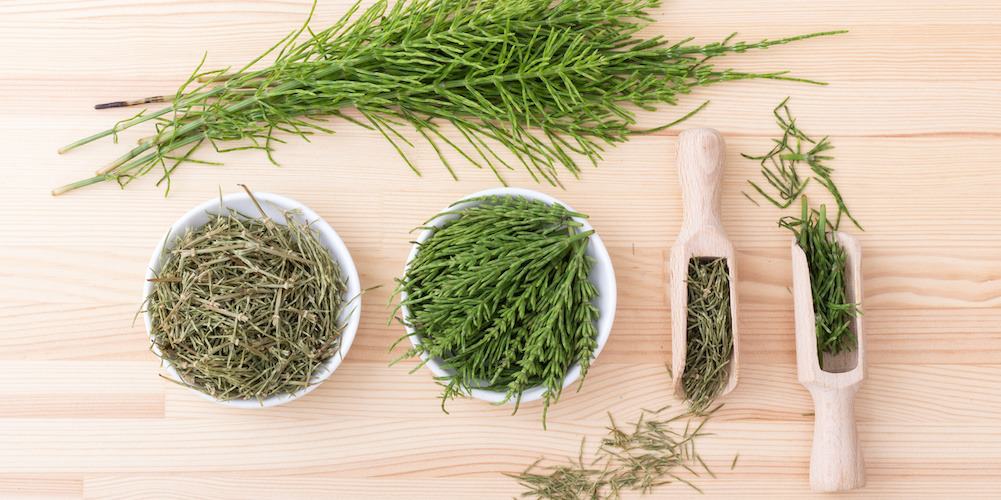What is horsetail?
Like nettle, horsetail (Equisetum arvense) is a common plant in our regions. It is found in Europe but also in North Africa, America, and Asia.
Also called “field horsetail“, it is nicknamed “horse-tail” or “rat-tail” because of its appearance.
This plant belongs to the Equisetaceae family, one of the oldest botanical genera in the world. It is used in many traditional medicines due to its numerous benefits.
Only the sterile stems are consumed. They contain many minerals and trace elements including silica.
They are also rich in antioxidants and vitamin C. Horsetail is especially known for its diuretic action on the body. Studies also show that it supports bone health, improves skin beauty, and diabetes. Finally, it is potentially anti-cancer.

Nutritional Composition
- Amino acids
- Vitamins: B1, C, E
- Minerals and trace elements: sulfur, magnesium, silicon, selenium, calcium, iron, manganese, phosphorus, potassium, zinc, chromium
- Proteins
- Fibers
- Fatty acids
- Antioxidant actives: flavonoids, saponins, tannins
- Organic acids: ascorbic, ferulic, malic, caffeic, gallic, pectic, tannic
Benefits of horsetail
💦 Diuretic
Like ginger and kale, horsetail is a natural diuretic. It thus promotes the elimination of waste from the body, aiding better removal through urine and supporting kidney function.
This plant is therefore interesting for clearing the body of toxins and other toxic substances: medications, heavy metals…
By stimulating urine production, it can also relieve mild urinary disorders. It has been beneficial in treating urinary stones, cystitis, and nephritic colic (increased pressure in the ureters).
This review from the Unilever Food and Health Research Institute (Netherlands) shows the diuretic potential of Equisetum species.
🦴 Supports bone health
Depending on the harvest season, horsetail can contain up to 60 g of silica per 100 g (in November). This trace element is naturally present in bones, muscles, tendons, and cartilage. It is thus essential for bone health and well-being.
The plant exerts a remineralizing effect. It facilitates calcium absorption and promotes bone regeneration, thus speeding up recovery in case of fracture.
At the same time, it is anti-inflammatory. It helps reduce inflammation and pain associated with arthritis or osteoporosis.
This study from Zhengzhou University (China), conducted on patients with rheumatoid arthritis, shows the benefits of horsetail on the disease.
🍑 Enhances skin beauty
Silica also contributes to the beauty and health of the skin. It notably promotes collagen production and stimulates cell renewal. Furthermore, it contributes to the elasticity and suppleness of tissues. Its benefits extend to nails and hair as well.
Horsetail has healing and regenerating properties. It is thus indicated to accelerate the healing of damaged tissues and minor wounds.
This study from Tabriz University of Medical Sciences (Iran), conducted on women, shows the healing action of horsetail.
🍭 Improves diabetes
By reducing blood sugar levels, it allows for better diabetes control. At the same time, it causes regeneration of the pancreas, the organ responsible for producing insulin.
But beware: its action is such that it can cause hypoglycemia. Therefore, people with diabetes should seek advice from their doctor before consuming it.
This study from the University of Urmia (Iran), conducted on rats, shows the anti-diabetic effect of horsetail.
🔬 Potentially Anti-Cancer
Thanks to its antioxidant activity, it is capable of reducing the proliferation of cancer cells. Furthermore, it induces apoptosis (programmed cell death). It has shown promise in the treatment of pancreatic cancer.
This study from the Baramulla Medical College (India), conducted on human cell lines, shows the anti-cancer potential of horsetail.

How to Consume Horsetail?
Horsetail in Capsules
The capsules contain powdered horsetail. This format is convenient, easy to take, and above all tasteless. It is ideal if you do not enjoy the slightly bitter flavor of the powder. These capsules are easy to find in stores, specialty shops, or online.
They should be sufficiently concentrated in silica (with at least a 5% content). Preferably choose capsules of plant origin.
Horsetail in Powder
Once harvested, the sterile stems of the plant are dried and then finely crushed. A green powder is obtained, to be used in cooking and cosmetics.
The powder mixes easily in a glass of water, fruit juice, or a smoothie. You can also add it to a yogurt, a soup, or sprinkle it on a salad. Its taste is not unpleasant but slightly bitter.
Finally, it is ideal for formulating homemade care and cosmetic products: hair masks, dry shampoos, creams, cataplasms…
Dried Horsetail
Dried stems can be used to prepare horsetail decoctions. Infuse 2 g of dried plant in 150 ml of boiling water. Leave for 10 minutes. Strain and sweeten with honey or lucuma powder.
You can enjoy this drink at any time of the day.
Horsetail Mother Tincture
The mother tincture is obtained from a hydro-alcoholic extraction of the plant’s fresh stems. It is rich in silica but contains alcohol. This format is therefore not recommended for pregnant women, children, or individuals with certain conditions.

Consume Sustainably: Prioritize Organic, Local, and Fair Trade Horsetail
✓ Il est possible de récolter de la prêle à l’état sauvage. Elle pousse dans de nombreuses régions de France. Cherchez du côté des zones humides et ombragées, des prairies, des bords de chemins et de ruisseaux. Récoltez-la de préférence en automne : c’est à cette période que sa teneur en silice est la plus élevée.
✓ De nombreux producteurs français cultivent aussi de la prêle. Privilégiez donc une culture origine France et en agriculture biologique. Il existe aussi des filières équitables qui soutiennent le travail des petits producteurs.
Dosage
The recommended dosage is 2 g of horsetail per day.
Avoid consuming it for more than 4 consecutive weeks.
Contraindications and Side Effects
The consumption of horsetail presents certain contraindications:
- As a precaution, it is not recommended for pregnant and breastfeeding women and young children;
- Individuals with kidney disorders or heart problems should avoid consuming it;
- Its consumption may interact with diuretic medications or those in the digitalis family. Consult your doctor if you are on medication;
- Because it may cause a loss of potassium, it is not recommended for individuals with hypokalemia.
The consumption of horsetail presents certain side effects:
- Digestive disorders
- Skin reaction
- Seborrheic dermatitis
If you experience side effects, stop consumption and consult a physician.
Sources and scientific studies
C I Wright, L Van-Buren, C I Kroner, M M G Koning, 2007, Herbal medicines as diuretics: a review of the scientific evidence.
Xin Jiang, Qingshan Qu, Ming Li, Shuzhai Miao, Xing Li, Wenli Cai, 2014, Horsetail mixture on rheumatoid arthritis and its regulation on TNF-α and IL-10.
Azam Asgharikhatooni, Soheila Bani, Shirin Hasanpoor, Sakineh Mohammad Alizade, Yousef Javadzadeh, 2015. The effect of equisetum arvense (horse tail) ointment on wound healing and pain intensity after episiotomy: a randomized placebo-controlled trial.
Soleimani Safiyeh, Fathiazar Baijani Fathallah, Nejati Vahid, Nazemiyeh Hossine, Shojaei Sadee Habib, 2007. Antidiabetic effect of Equisetum arvense L. (Equisetaceae) in streptozotocin-induced diabetes in male rats.
Ajaz Ali Bhat, Bilal Ahamad, Muneeb U Rehman, Parvaiz Ahmad, 2020. Impact of ethanolic extract of Equisetum arvense (EA1) on pancreatic carcinoma AsPC-1 cells.



